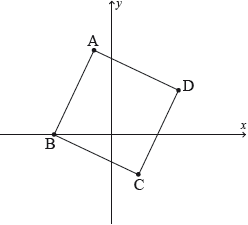| Date | May 2022 | Marks available | 2 | Reference code | 22M.1.AHL.TZ2.12 |
| Level | Additional Higher Level | Paper | Paper 1 (without calculator) | Time zone | Time zone 2 |
| Command term | Express | Question number | 12 | Adapted from | N/A |
Question
In the following Argand diagram, the points , and are the vertices of triangle described anticlockwise.
The point represents the complex number , where . The point represents the complex number , where .
Angles are measured anticlockwise from the positive direction of the real axis such that and .
In parts (c), (d) and (e), consider the case where is an equilateral triangle.
Let and be the distinct roots of the equation where and .
Show that where is the complex conjugate of .
Given that , show that is a right-angled triangle.
Express in terms of .
Hence show that .
Use the result from part (c)(ii) to show that .
Consider the equation , where and .
Given that , deduce that only one equilateral triangle can be formed from the point and the roots of this equation.
Markscheme
(A1)
A1
AG
Note: Accept working in modulus-argument form
[2 marks]
A1
(as ) A1
so is a right-angled triangle AG
[2 marks]
EITHER
(since ) (M1)
OR
(M1)
THEN
A1
Note: Accept working in either modulus-argument form to obtain or in Cartesian form to obtain .
[2 marks]
substitutes into M1
A1
EITHER
A1
OR
A1
THEN
and A1
so AG
Note: For candidates who work on the LHS and RHS separately to show equality, award M1A1 for , A1 for and A1 for . Accept working in either modulus-argument form or in Cartesian form.
[4 marks]
METHOD 1
and (A1)
A1
A1
substitutes into their expression M1
OR A1
Note: If is not clearly recognized, award maximum (A0)A1A1M1A0.
so AG
METHOD 2
and (A1)
A1
A1
substitutes and into their expression M1
OR A1
Note: If is not clearly recognized, award maximum (A0)A1A1M1A0.
so AG
[5 marks]
A1
for
and which does not satisfy R1
for
and A1
so (for ), only one equilateral triangle can be formed from point and the two roots of this equation AG
[3 marks]
Examiners report
The vast majority of candidates scored full marks in parts (a) and (b). If they did not, it was normally due to the lack of rigour in setting out of the answer to a "show that" question. Part (c) was, though, more often than not poorly done. Many candidates could not use the given condition (equilateral triangle) to find in terms of . Part (d) was well answered by a rather high number of candidates.
Only a handful of students made good progress in (e), not even finding the possible values for .


